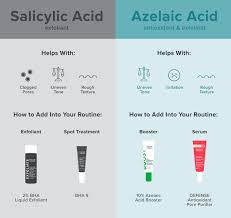
What can you mix azelaic acid with?
If you’ve been around for a while, you know that we’ve been focusing a lot on azelaic acid lately and its effects on the skin. This powerful ingredient contains antibacterial and anti-inflammatory properties, making it a highly effective ingredient for a variety of skin types, from acne-prone skin to skin with rosacea. When applied to the skin, this acid can address issues and improve the overall look and feel of your complexion.
Azelaic acid is commonly found in a variety of formulas, both over-the-counter and doctor-prescribed. The latter usually contain higher concentrations of the acid in their formulas.
The main benefit you’ll find from using azelaic acid is that it can significantly improve signs of hyperpigmentation and discoloration caused by melanin. You’ll also find that it can clear up acne breakouts or signs of redness and rosacea on your skin. If you’d like to learn more about azelaic acid and the benefits you can expect from using it, check out our dedicated blog post on Beauty Insiders.
Can Azelaic Acid be used with other acids?
You certainly can. In fact, you’ll find that many experts recommend that you use azelaic acid in combination with acids, even acids that are as effective as salicylic and glycolic acid. However, it’s important to use these acids every other day. It’s the easiest way to benefit from the exfoliating and rejuvenating properties of these powerful ingredients without having to worry about it being too much for the skin and causing too much irritation.
As for other acids like hyaluronic acid, there’s no qualms about layering azelaic acid with this clever moisturizer.
Don’t let its name fool you, hyaluronic acid works differently than other exfoliating acids. Instead, it draws water from the surrounding area of the skin and locks it in place. Not only does this counteract any potential drying effects of azelaic acid, it also ensures that the lipid barrier on the surface of the skin is strengthened and moisturized.
What Not to Mix with Azelaic Acid?
As I mentioned before, you can use other acids with azelaic acid, but it’s best not to layer these ingredients together.
This can cause the skin to over-exfoliate and strip it of important oils and moisture. This can lead to overproduction of sebum (the natural oil in the skin) and excess sebum production. This can have a snowball effect that can lead to acne, breakouts, and oily skin.
There’s more to know about what not to mix with azelaic acid, so check out our blog post.
What to Apply Before and After Azelaic Acid?
A lot depends on the formula containing azelaic acid, as this will determine at which stage you apply it. I talked about the general rule of applying skincare products from thinnest to thickest in a previous blog post. If you choose a cleanser or toner with azelaic acid, you will need to follow up with a serum and moisturizer.
For convenience, you should always cleanse your skin thoroughly with a cleanser or face wash before applying azelaic acid. This will loosen the dead skin cells from the outer layer of the skin. You can then apply an azelaic acid product, which will slough off these dead skin cells and make way for other active ingredients to penetrate into the lower layers of the epidermis.
As I mentioned, azelaic acid can be drying for some skin types, so after using it, you will want to apply a serum with moisturizing ingredients like hyaluronic acid and niacinamide. This helps maintain the skin barrier function, leaving the skin healthy, hydrated, and radiant.
Can I use niacinamide with azelaic acid?
Yes, you can certainly use niacinamide and azelaic acid together. Often thought of as acting similarly to hyaluronic acid, niacinamide is considered a very useful ingredient, especially for those who are prone to acne. This is because this hydrating powerhouse reduces inflammation, retains moisture in the skin, and works with the skin barrier to ensure it remains healthy.
While both niacinamide and azelaic acid work for the skin, everyone’s skin is different. Therefore, it is important to consult with a doctor, dermatologist, or trained professional to determine which active ingredients and percentages will work for your skin and produce the desired skin effects.
Is Azelaic Acid an AHA or BHA?
Azelaic acid is not an alpha hydroxy acid like glycolic or lactic acid, nor is it a beta hydroxy acid like the popular salicylic acid. Although it works in a similar way to these popular acids, azelaic acid is actually a dicarboxylic acid that is produced naturally in the body using yeast found in the skin. To formulate skin care products, it is extracted from yeast found in barley, wheat, cereals, and rye, and then made in a lab into a clever ingredient in many skin care formulas.
How often should you use azelaic acid?
Azelaic acid is generally considered one of the gentler acids. How often you use it depends on you and your skin type. If this is your first time using this acid, I recommend that you slowly introduce azelaic acid into your daily skincare routine to avoid unwanted side effects. Start using it in the evening to allow your skin to build up tolerance. As an extra precaution, I would also like to remind you to apply an SPF 30 or higher sunscreen in the morning.
That’s it, I hope I answered your questions about azelaic acid and what you can mix it with. If you have any other questions, don’t forget to find me on Instagram.


